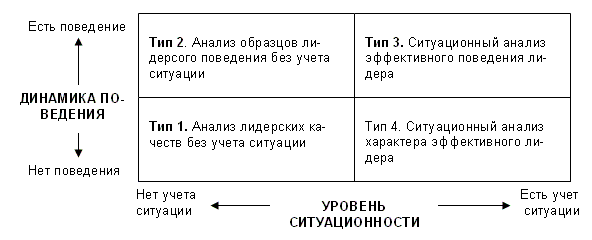home
 Management Management
 Management - Vikhanskiy OS Management - Vikhanskiy OS
|
Management - Vikhanskiy OS
1.4. Approaches to Leadership Studies
It is known that by now more than ten thousand different kinds of studies on leadership issues have been conducted. Using two variables or two dimensions (the dynamics of behavior and situationalness), we can identify the main groups of leadership.
The dynamics of behavior reflects how the leader is treated: in statics (leadership analysis) or in dynamics (analysis of leadership patterns). In the first case, leadership is treated mainly in terms of the permanent and stable qualities of the character of the individual, i.e. It is believed that the leader, as it were, has certain innate traits that are necessary for him to be effective. In contrast, the behavioral approach is based on conclusions drawn from observational samples of leadership behavior, i. E. Actions of the leader, and not inherited qualities.
The second dimension is related to the level, or degree of acceptance of situationality, as the basis of analysis within the framework of this or that approach to the study of leadership. At one pole are approaches that lead to the idea of universality, on the other - situationality is recognized as critical, decisive for effective leadership.
The combination of the two variables ultimately leads to the identification of four types of approaches to the study of leadership in the organization (Figure 11.5). The first type includes approaches based on the analysis of leadership qualities (theory of leadership qualities, the theory of "X" and the theory of "Y" by Douglas McGregor) needed for an effective leader in any organizational context.

Figure 11.5. Types of Approaches to Leadership Studies 480
The second type considers leadership as a set of patterns of behavior inherent in the leader also in any organizational environment (studies of the University of Michigan and Ohio State University, Lickert management systems and the management grid of Blake and Mawton).
The third type involves the study of leadership qualities, but already depending on the specific situation (the concept of situational leadership: Tannenbaum-Schmidt, Fiedler, Hersay-Blanchard, House-Mitchell, Stinson-Johnson, Vroom-Yetton-Yago).
The fourth type represents a number of new approaches, which again study leadership qualities, but already in connection with the concrete situation (the cause-effect approach, or the "attributive" theory, the concepts of the leader-transformer and the charismatic leader). These approaches attempt to define a set of qualities and behaviors that a leader needs in a specific organizational context. Each of these approaches will be examined in detail below in order to assess its significance and usefulness in explaining leadership and the possibility of predicting leadership behavior with it.


Comments
When commenting on, remember that the content and tone of your message can hurt the feelings of real people, show respect and tolerance to your interlocutors even if you do not share their opinion, your behavior in the conditions of freedom of expression and anonymity provided by the Internet, changes Not only virtual, but also the real world. All comments are hidden from the index, spam is controlled.